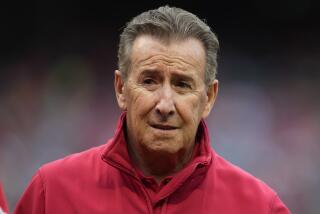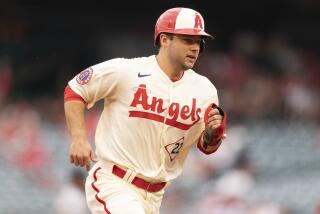For every Mike Trout in the draft, there are hundreds of swings and misses by the scouts

Inside the Angels’ clubhouse at Tempe Diablo Stadium this spring were three potent reminders that baseball scouts make mistakes.
At one end of the room sat Dustin Ackley, the second selection in the 2009 Major League Baseball draft, who received one of the largest contracts ever committed to an amateur ballplayer. A bust with the Seattle Mariners, he was in camp as a non-roster invitee, trying to stick as a utilityman.
At another end of the room was Tony Sanchez, the fourth pick in 2009, another non-roster invitee. He was thought to be ticketed for triple-A and was hoping to be the first catcher the Angels call up to the majors in the event of an injury.
Then there was Mike Trout, pick No. 25 in the same draft, the face of the Angels and generally regarded as the best baseball player in the sport. At age 25, he’s probably already two-thirds of the way to the Hall of Fame.
“Twenty-one picks behind me,” Sanchez said. “That was stupid.”
Ackley, Sanchez and so many others were unfamiliar with Trout at the time of the draft. And most of the people who were familiar with him opted against selecting him for reasons they would soon regret.
“At the time,” Ackley said, “you’re not thinking any differently about anybody in the first, second or third round. You’re just thinking everybody’s a player, not that this guy’s a freakin’ superstar. It’s still crazy to wonder: Why did he go 25th? Was he not this guy in high school? That’s the question. It’s confusing.”
::
About one month before the 2009 draft, Arizona Diamondbacks scouting director Tom Allison had a connection at Philadelphia International Airport on his way to Long Island, where he planned to watch a young left-hander named Steven Matz, a future New York Met.
At the airport, Allison received word from his area scout that Matz’s game would be cancelled because of rain, so he resorted to his Plan B: He picked up a rental car and made the 50-minute drive to Millville, N.J., where Trout was playing.
It was the third time he’d seen Trout, dating to the previous summer, when the outfielder’s club team played in Phoenix. In between, the Diamondbacks’ area scout monitored Trout and became enamored with his comportment. One of the Diamondbacks’ Illinois-based major league scouts, Joe Bohringer, made calls on his character and heard the same. The kid loved playing baseball.
Bohringer enjoyed an unusual connection: Two decades before, he attended Trout’s high school. Bohringer’s mother still lived less than two miles from small-town Millville Senior High. He called his old friends and asked if they knew the Trout family.
“It was almost like high school reunion time,” Bohringer said.
The Diamondbacks were definitely interested in Trout, and they had the 16th and 17th picks in the draft. The San Francisco Giants, selecting sixth, and the Oakland A’s, with the 13th selection, also were considered possible landing spots for Trout. And the New York Yankees, it was well known, had an eye on the local kid too, but they would pick 29th.
Specific details of the third time Allison saw Trout are lost to history, but he came away concerned about Trout’s ability to hit in the majors. He downgraded the prospect on the Diamondbacks’ draft board.
“Mike was not a very polished hitter,” Allison said. “He was a very strength-oriented hitter.”
Other scouting directors shared that perspective. Like most children of the Northeast, Trout did not play many high school games that spring — between 20 and 25. Scouts’ visits often were rained out, and the level of competition was always questioned.
Allison also noted that the top right-handed hitters in baseball at that time were uniformly not drafted out of high school. “In the industry,” Allison said, “that’ll put you on your heels a little bit.”
At least one scout asked Trout to take batting practice left-handed. He did, but even though his father, Jeff, was a switch-hitter, he was happy batting right-handed.
In high school, Ackley played at North Carolina’s lowest competition level and never attracted draft interest because of it. Kids who excelled in his league did not often fare as well in college. So he understands the predicament with a teenage Trout, to a degree.
“My thing with that is projection,” Ackley said. “If scouts are about projection, you’ve got a freakin’ fullback that can fly, with power. How does that not project?”
::
Six players picked in front of Trout never reached the majors.
The 23rd pick, Louisiana State center fielder Jared Mitchell, surfaced in the Angels’ minor league system in 2015. La Verne Bonita High shortstop Jiovanni Mier, pick No. 21, stopped hitting in triple-A. Oklahoma high school left-hander Chad James, picked 18th, failed five drug tests and was suspended.
Arizona’s pick at No. 16, Bobby Borchering of Fort Myers, Fla., peaked in double-A, where he used to show his teammates highlight videos of his high-school swing. Georgia high school outfielder Donovan Tate, the third pick in the draft, signed a $6.25-million bonus with the San Diego Padres, then hit a total of 10 homers in parts of six professional seasons and never advanced beyond Class A.
Matt Hobgood, a massive Norco High right-hander and surprise No. 5 pick by the Baltimore Orioles, underwent two shoulder surgeries and pitched in six games above Class A. He’s attempting a comeback as a hitter. In May, he’ll travel to Texas for spring training with the Cleburne Railroaders, an independent-league expansion team.
For so long, he’s heard from Orioles fans on Twitter about Trout, and how they wished so badly that the Orioles had taken him instead.
“I look back and I’m like, ‘Yeah, they probably should’ve,’” Hobgood said. “I don’t blame them.”
::
In 2009, Major League Baseball broadcasted its amateur draft on prime-time television for the first time, live from its MLB Network studios in Secaucus, N.J., a two-hour drive from Trout’s hometown. League officials invited several top prospects to attend. Trout was the only one who accepted.
He attended school that Tuesday, left early, and drove over.
On the miniature field the network uses as a studio, Trout’s group gathered in the third-base dugout to celebrate the day. His family believed he could go as high as second to the Mariners, who took Ackley instead. Trout’s party waited more than an hour until they could erupt to the news that he was pick No. 25, seven selections before the broadcast finished.
“There was pressure,” Trout told reporters on stage. “It would’ve been bad if I didn’t get picked.”
It has often been reported that the Angels had Trout second on their overall board, but he was no higher than seventh and likely lower, according to two people who were in the draft room. Strasburg, Hobgood, and Borchering, among others, were rated above him. Eddie Bane, then the Angels’ scouting director, ranked Trout second on his personal list, and he ordered the selection.
In all, 33 prospects have attended the MLB draft. Only nine waited longer than Trout to be selected.
Angels right-hander Garrett Richards, pick No. 42 in 2009, has roomed with Trout for the better part of the last eight seasons. He learned of him that day.
“I still give him crap about it,” Richards said.
::
A year later, the All-Star Game came to Angel Stadium, and Trout was the youngest player invited to play in the Futures Game that preceded it. He didn’t start, but in his first at-bat he pounded a grounder to the left side of the infield and with his speed made it a hit.
“At 18 years old, he looked like a college linebacker,” said Angels second baseman Danny Espinosa, who played in the game. “And he gets the infield hit, and you’re like, ‘Holy [expletive], how is this guy moving like this?’”
Later, Trout flashed his speed again on a groundout, and he stretched a single into a double. Angels outfielder Ben Revere, Trout’s locker-mate that day, still remembers being disoriented by Trout’s double.
“That’s when the birth of Mike Trout was known,” Revere said.
Several scouts clocked both runs from home to first base at better than 3.9 seconds, unheard of for a right-handed batter. Even left-handed batters who run that time are considered to have 80 speed, in scouting parlance. The scouting scale spans from 20 to 80.
“Everybody at the game was showing each other their stopwatches, saying, ‘You can’t do that,’” Bane recalled. “Unless you’re his daddy, I can’t imagine feeling any better than that.”
One year and one month later, Trout was in the major leagues.
“People doubted me,” he said this spring. “A lot of teams passed on me. I always told myself to try to prove everybody wrong.”
Even now, Trout said, he uses those doubters — and, he says, new ones — to fuel his play.
“With all the social media, Instagram, you’re going to have 90% of people talk good about you, but there’s going to be 10% that doubt you,” he said. “Anything you do, you can do so good and then they can pull up a stat where you need to improve.
“I don’t mean that in a bad way, but if you have a bad game, you’re going to hear about it. It’s going to be everywhere. You’ve got to prove people wrong.”
In 2009, Allison and Bohringer’s Diamondbacks did select the second-best player to emerge from that class, Paul Goldschmidt, in the eighth round. The draft was not wasted.
They both work for Seattle now, Allison as the Mariners’ top scouting executive and Bohringer as a special assistant to general manager Jerry Dipoto. They’ve used Trout’s rise as a lesson about the importance of recognizing passion and self-belief.
“We have to admit that we just kind of missed on the talent,” Bohringer said. “But there’s something to be said about the work ethic and the person. There’s something to be said about making sure you understand that.”
And about marveling at the extent to which 21 teams and hundreds of scouts were wrong about baseball’s biggest star.
“Revisionist draft history,” Allison said, “is the best.”
Twitter: @pedromoura
More to Read
Go beyond the scoreboard
Get the latest on L.A.'s teams in the daily Sports Report newsletter.
You may occasionally receive promotional content from the Los Angeles Times.







